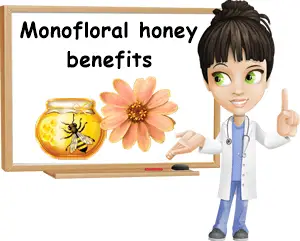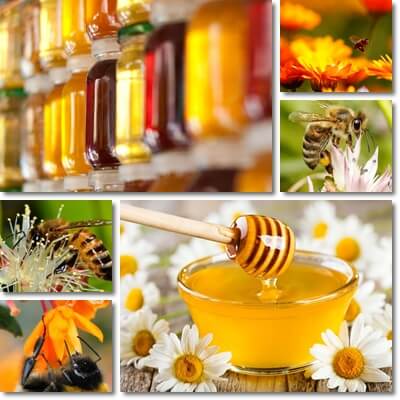Monofloral honey is a type of honey made for the most part from the flower nectar and pollen of one flowering plant, but may contain smaller amounts of other flower nectars as well. For a honey to be considered monofloral, the secondary flower nectars present in its composition must have a poor representation so they do not alter the overall flavor profile and color of the predominant nectar source. The stronger and more distinctive the characteristics of the primary flower nectar in a honey, the purer the honey and the higher its price.
What is monofloral honey more exactly? Monofloral honey is also known as unifloral or single-flower honey, the names suggesting it is a honey made from one flower nectar. However, monofloral honeys aren’t exclusively made from one flower nectar, but from several. What makes monofloral varieties different from polyfloral types is the representation of the flower nectars in their composition. Monofloral varieties are expected to have one primary nectar source that enjoys the highest representation in the honey and dominates the flavor profile and appearance.

Secondary nectars, although present, are expected to be in small enough amounts that they do not overpower the taste and color the primary nectar gives to the honey. In other words, secondary nectars are but contaminants with no visible representation in the final product. Their presence may take the form of faint flavor notes or weak scents that enrich the main aroma of the honey without altering or overwhelming it. The clearer the aromatic profile of a monofloral honey and the purer its color, the higher its price and the more appreciated the product.
In the case of polyfloral varieties, nectar composition is dictated by honey bees who choose what nectars to source and in what amounts. Nevertheless, even with polyfloral honeys, beekeepers often aim to reproduce the honeys that have had the most success with their customers so they seek to locate their honey bees in areas where there are flower species needed to make a honey with a certain taste and appearance. Unlike monofloral varieties, polyfloral ones usually have a varying nectar composition, with different percentages of different flower nectars. Both unifloral and polyfloral varieties are different from honeydew honey.
How is monofloral honey made?
In order to produce a monofloral variety, beekeepers need to first prepare the honey bees by locating them in a certain region where there is a plentiful supply of a certain flowering plant. Because different plants bloom in different times of the year, timing is also crucial. Before proceeding to make the honey, beekeepers also need to clear the leftover honeys from the hive so the new production isn’t contaminated. The location needs to chosen carefully so the main nectar supply isn’t in competition with another because honey bees will not discriminate between food sources and the resulting honey might not be a single-flower one.
As the blooming season comes to an end, beekeepers also have to harvest the honey before their bees go in search of other nectars and contaminate the existing honey with new flavors. If one can find a plentiful food source, honey bees can make monofloral honey from virtually any flower. Different varieties of honey will have different colors, flavors and a different crystallization time.

What do monofloral honeys look and taste like? Honeys can be clear, almost whitish in color, light yellow, amber, medium amber or dark amber, with or without brownish, reddish, greenish reflexes. Some may even be dark purple or black-colored. Their taste may range from mildly sweet to very strong, with an incredible range of flavors, from pleasant floral or fruity notes to warm woody, herbal or hay-like aromas, medicinal, peppery, salty, caramel, butterscotch, vanilla, minty, musky and other savoury flavors. Honey can be exclusively sweet, mildly astringent or have a bitter aftertaste and crystallize as soon as a few weeks after harvest or in years.
Health effects
What are the health benefits of monofloral honeys? Monofloral varieties share roughly the same benefits as polyfloral or honeydew honeys, possessing impressive antibacterial, antioxidant, anti-inflammatory, immuno-modulating, demulcent and other properties. However, flower nectars may come with surprising medicinal elements from the plant of origin and have the potential of greatly upgrading the therapeutic action of a monofloral honey.
Let’s take as example manuka honey. It is a monofloral variety with several remarkable health benefits (read more about the properties and benefits of manuka honey). The purer the honey, the higher its therapeutic value. And there aren’t other monofloral honeys with such an impressive medicinal activity as manuka, except maybe those made from related species (kanuka honey, for example). Similarly, (false) acacia honey boasts a low allergenic potential. Chestnut honey has a surprisingly high content of dietary minerals compared to other honeys.
And so, different monofloral varieties enjoy unique properties that make them stand out from the point of view of their therapeutic potential. This being said, here are 17 great properties, benefits and uses of monofloral honey:
1) Natural antibacterial, antifungal, antiseptic and antibiotic.
2) Promotes faster wound healing (wounds, burns, ulcers).
3) Stimulates the immune system and strengthens the body.
4) Promotes faster recovery after respiratory infections.
5) Good for sore throat and cough, common cold and tonsillitis.
6) Soothes stomach upset.
7) Natural treatment for gastritis.
8) Helps reverse acid reflux damage.
9) Good for slow transit and possibly constipation.
10) Has prebiotic benefits and improves digestive health.
11) Anti-acne action, reduces excess sebum.
12) Great for dry, dull skin and sensitive skin.
13) Natural remedy for uneven skin tone.
14) Source of vitamins, minerals and antioxidants.
15) Tonic, energizing properties, combats fatigue and hypoglycemia.
16) Improves appetite.
17) Helps induce sleep faster.
Monofloral honeys are a source of strong antibacterial elements like methylglyoxal, hydrogen peroxide, pollen particles with immuno-modulating action and antioxidants with antimicrobial activity. Natural wound dressings using honey are currently being developed for faster wound healing time, including the healing of burns. Honey can also be used daily to prevent acne breakouts because it reduces bacteria numbers on the face as well as excess sebum which bacteria feed on.
In my experience, it is a wonderful remedy for uneven skin tone problems. It also calms skin irritation and is great for dry skin, nourishing and hydrating it and restoring radiance. Despite containing small amounts of vitamins and minerals, monofloral honeys have a strengthening effect on the body and the immune system, supporting a stronger response in case of infection and disease. They are reported to help improve appetite, induce sleep, combat fatigue and hypoglycemia and boost energy levels.
Lastly, monofloral honeys are good for stomach health. Not only do they help soothe an irritated stomach lining, but some even encourage the stomach to regenerate itself, helping heal gastritis naturally. They have a similar effect for acid reflux problems, potentially helping reverse damage to the esophagus. Honey forms a sort of protective coating over mucous membranes, preventing further damage and allowing them to recover, hence its contribution to gastritis and acid reflux treatment, but also its efficacy in calming cough and soothing a sore throat. The natural sugars it contains have a prebiotic action, feeding the good bacteria in our intestinal tract and, by this, improving transit and possibly relieving constipation.
Conclusion
Monofloral honeys can be a wonderful addition to any diet, provided you are not allergic to pollen or honey bees, in which case it is best to avoid eating honey. Also, in order to enjoy all they benefits they have to offer, it is important to choose raw, unprocessed, unheated and unadulterated honey from responsible producers with a tradition for clean honey making. And remember, real honey is pricey, but worth every penny because it delivers all of the promised benefits. If you suffer from any medical condition that may prevent you from eating honey such as diabetes, pollen or other allergies, talk to your doctor first.
